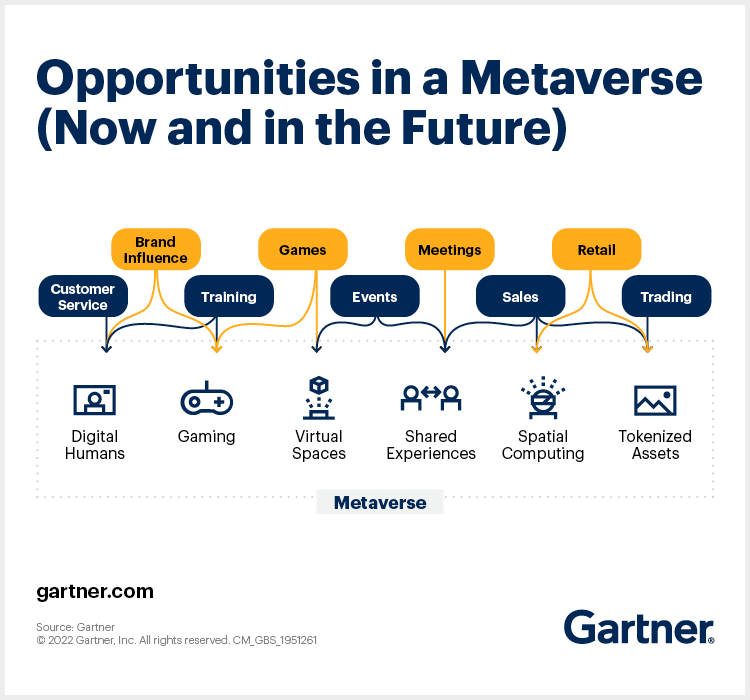According to MCKINSEY, The metaverse is the emerging 3-D-enabled digital space that uses virtual reality, augmented reality, and other advanced internet and semiconductor technology to allow people to have lifelike personal and business experiences online.
The Metaverse is a futuristic concept within the digital world, it’s a mix of reality and imagination that comes alive, driving unique experiences for users. The Metaverse today is innovating, growing, and evolving without bounds, opening up immense opportunities for human play, socializing, work, and exploration. It allows businesses to create and transact through digital assets, thereby opening up new ways of conducting commerce.
Also Read: Redefine IT Security Paradigms with Zero Trust Architecture
 Brief History of Metaverse
Brief History of Metaverse
The beginnings of the metaverse date back to the 20th century. Neal Stephenson, who coined the term in his 1992 novel Snow Crash, envisioned a scenario where people retain their status graded by the technical competency of an avatar in a virtual setting. This spawned such programs as Google Earth and NASA World Wind.
Ready Player One, a novel by Ernest Cline in 2011 and popularized by Steven Spielberg’s movie adaptation, mentioned the metaverse. It was about The Oasis—a virtual escape that users interacted with through VR headsets and haptic gloves, underscoring a strong emphasis on tactile feedback.
On an even deeper level, deep metaverse technologies began development back in the 1960s. Other waves of hype include the early 2000s growth, with the later platting of Second Life, and the early 2010s initial excitement around VR headsets that never seemed to materialize as metaverse gateways but drove big technological improvements.
Metaverse As It Is Now
The metaverse is getting substantially real in 2024 at the intersection of technology and human imagination. Advances in AI and the development of powerful chips have enhanced computing capabilities, promising long-term success beyond the initial hype. The future of AI is expected to be defined by its practical applications.
AI can transform virtual production in the metaverse by leveraging its convergence to reinvent how users perceive, communicate, and interact in immersive undertakings. This confluence will allow deeper engagements within digital realms and unlock alternative pathways for the development of the virtual world.
Tech leaders, such as Apple and Meta, are storming the metaverse market with their VisionPro headsets and Ray-Ban smart glasses, showing major and key technological changes taking place before the year 2024.
The minimally invasive implant technologies on the Neuralink, is set to start human clinical trials by 2024, marking the absolute milestone in brain implant technologies. Though its full impact on the metaverse would be a long-term process, the Neuralink technology holds great potential to divert future metaverse evolution.
Aslo Read: CIO Influence Interview with David Sztykman, VP of Product management of Hydrolix
Significance of Cybersecurity in Metaverse
Cybersecurity in the metaverse has become important for platform owners’ as they use the metaverse for various functions. This is needed to build trust among users and keep their data safe from potential cyber threats in the real world. A good cybersecurity framework will mean reputation protection and long-term durability.
The metaverse has made its impacts felt in the real world. Major technology players and property owners are looking to invest in the metaverse agenda as it holds promise. Within the metaverse, security breaches can give rise to tangible consequences for businesses, such as potential reputation damage and harming overall prospects. On the inverse of this, positive experiences within the metaverse could enhance real-life achievements in status.
Where regulations are not yet well established, putting the focus on cybersecurity makes room for a more competitive effect. As they offer a secure environment, they attract users and are taking up the prime position as standard-setters—in regulating the metaverse of the future. This proactive stance doesn’t just drive early business growth but also lays the foundation for long-term success in the evolving metaverse landscape.
Also Read: Cybersecurity Essentials for Aviation and Aerospace
Metaverse – Cybersecurity Challenges To Keep in Mind
Moderation challenge:
The huge volume of generated content and the lack of a unified approach to the regulation of content seriously threaten the possibility of proper content and behavior moderation in the metaverse.
Milky ways remain for identifying and managing harmful content with the development of effective tools and technologies. Current moderation tools may not be able to cope with the unique challenges brought by the virtual world.
Another level of complication in the moderation efforts by users is added by the lack of support or assistance in various aspects.
The Child Safety in the Metaverse issue is quite severe. Eased targets of cyberbullying, grooming, and even inappropriate content. Misrepresenting one’s age or using false identities is pretty easy; therefore, developing age-appropriate moderation standards isn’t quite an easy feat.
Decentralized Structure and Identity Theft:
Cybercriminals can gain stealth access to user data through the decentralized structure of the metaverse, thereby opening a pathway for fraudulent activities and unauthorized account and service access. Identity theft has become a serious issue here because, with the current methods, there is no system in place to prevent any user from creating a digital avatar that perfectly mimics another person’s identity and appearance.
Data Theft:
The metaverse contains massive quantities of confidential information and IP addresses, which creates a big data privacy worry for governments, regulators, and internet users. The development of avatars to “live” and “co-exist” in the metaverse requires enhanced data exchange and exposure with digital enterprises.
There is a strong fear that the metaverse login will generally raise one’s level of monitoring and assessment of online activities, with the data to be sold to advertisers. The more personal information in the metaverse, the higher the danger of stealing private information.
This would further mean more sensors in homes and businesses for the realization of the full potential of the metaverse. While these devices would track every activity and behavior of users in real-time, they would also be more vulnerable to other targeted cyber-attacks.
Cyberbullying:
The dynamic environment of the metaverse, where users create and exchange content, presents significant challenges in content moderation. Ensuring safety and appropriateness of content is difficult due to the vast and diverse virtual landscape.
Cyberbullying in the metaverse demands robust content control strategies. The decentralized nature of the metaverse complicates these efforts, as standard moderation systems struggle to manage the enormous volume and variety of information produced in this digital realm.
Cybersecurity Considerations of Metaverse for IT and Security Teams
- Design secure protocols: Metaverse developers should include robust security protocols that protect users’ personal and financial information. This would consist of encryption technologies, two-factor authentication, secure communication channels, etc., susceptible to the protection of sensitive information from unauthorized access.
- Activate AI-driven security tools: AI-based security tools, such as anomaly detection algorithms and behavior-based threat analysis, can help detect and prevent the likelihood of cyber-attacks.
- Collaboration with Governments and Institutions: Developers, governments, and institutions should integrate so that the metaverse has globally set standards of cybersecurity in order to assure adherence to already set laws and regulations on the issue. This will raise awareness about cybersecurity.
- Develop Community-Driven Moderation: The challenge of moderation in the metaverse can be handled using a community-driven moderation method. This is to empower users to report or flag inappropriate content or behaviors, hence enforcing community standards to regulate user behavior.
- Educate users on cybersecurity risks and best practices. Resources and guidelines on safe passwords, safe browsing, and social engineering attacks help users act safely in the metaverse.
- Prioritize Transparency: Developers should prioritize users’ privacy; this can be done by setting limits to the collection and using anonymization technologies while implementing data protection laws and regulations. Privacy is essential for developing trust among users in the metaverse.
Conclusion
Although the metaverse is full of magnificent and promising opportunities, but it also comes with overwhelmingly high cybersecurity risks that require due care. A secure metaverse ecosystem should be established in order to safeguard users from threats like phishing and data theft.
Businesses should develop security measures such as single sign-on and multi-factor authentication based on a decentralized structure that strengthens metaverse platforms against malware and illegal activities. A beefed-up set of security features defines the future of the metaverse, which is safe and prosperous for all of us to function digitally, be creative, and make inventions with confidence.
Although the metaverse itself is still in its early phase, it holds huge potential for completely changing the scenario of cyberspace security. Features such as digital identity verification and secure asset management can enhance the safety bar of business enterprises and people worldwide. In addition, by providing an avenue for safe interactions and transactions, the metaverse would rewrite the new future of electronic commerce.
FAQs
1. What are the Cyber considerations for the Metaverse?
- Digital impersonation
- Interoperability
- Account takeover risk – credential replay attack
- Data protection/Misuse
2. How users can protect themselves from Metaverse Crime?
- Secure Your Accounts
- Protect Personal Information
- Choose Reputable Platforms
- Be Cautious of Virtual Relationships
- Report and Block
- Educate Yourself
- Keep Software Updated.
- Use Virtual Private Networks (VPNs)
3. What are some practical applications of the Metaverse?
The Metaverse has practical applications across various sectors, including gaming, education, entertainment, social networking, virtual events, real estate, healthcare, and remote work. It allows for virtual meetings, immersive learning experiences, virtual tourism, virtual commerce, and more.
4. How does the Metaverse differ from the internet?
While the internet primarily consists of websites and digital content accessible through browsers, the Metaverse offers a more immersive and interactive experience. It enables users to interact with each other and digital objects in real-time, often using avatars or virtual representations of themselves.
[To share your insights with us as part of editorial or sponsored content, please write to psen@itechseries.com]


